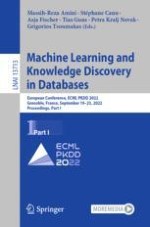1 Introduction
-
Introducing the ProtoMIL method, which substantially improves the interpretability of existing MIL models by introducing case-based reasoning.
-
Developing a training paradigm that encourages generating prototypical parts from the underrepresented instances responsible for the positive label of a bag.
2 Related Works
2.1 Multiple Instance Learning
2.2 Explainable Artificial Intelligence
3 ProtoMIL
4 Experiments
4.1 Bisque Breast Cancer and Colon Cancer Datasets
|
Method
|
Bisque
|
Colon Cancer
|
|||
|---|---|---|---|---|---|
|
Accuracy
|
AUC
|
Accuracy
|
AUC
|
Inter.
|
|
|
instance+max*
|
\(61.4\%\pm 2.0\%\)
|
\(0.612\pm 0.026\)
|
\(84.2\%\pm 2.1\%\)
|
\(0.914\pm 0.010\)
|
+
|
|
instance+mean*
|
\(67.2\%\pm 2.6\%\)
|
\(0.719\pm 0.019\)
|
\(77.2\%\pm 1.2\%\)
|
\(0.866\pm 0.008\)
|
−
|
|
embedding+max*
|
\(60.7\%\pm 1.5\%\)
|
\(0.650\pm 0.013\)
|
\(82.4\%\pm 1.5\%\)
|
\(0.918\pm 0.010\)
|
−
|
|
embedding+mean*
|
\(74.1\%\pm 2.3\%\)
|
\(0.796\pm 0.012\)
|
\(86.0\%\pm 1.4\%\)
|
\(0.940\pm 0.010\)
|
−
|
|
AbMILP*
|
\(71.7\%\pm 2.7\%\)
|
\(0.856\pm 0.022\)
|
\(88.4\%\pm 1.4\%\)
|
\(0.973\pm 0.007\)
|
++
|
|
SA-AbMILP**
|
\(75.1\%\pm 2.4\%\)
|
\(0.862\pm 0.022\)
|
90.8% ± 1.3%
|
0.981 ± 0.007
|
+
|
|
ProtoMIL (our)
|
76.7% ± 2.2%
|
0.886 ± 0.033
|
\(81.3\%\pm 1.9\%\)
|
\(0.932\pm 0.014\)
|
+++
|
4.2 Camelyon16 Dataset
4.3 TCGA-NSCLC Dataset
|
Method
|
Camelyon16
|
TCGA-NSCLC
|
TCGA-RCC
|
||||
|---|---|---|---|---|---|---|---|
|
Accuracy
|
AUC
|
Accuracy
|
AUC
|
Accuracy
|
AUC
|
Inter.
|
|
|
instance+mean*
|
79.84%
|
0.762
|
72.82%
|
0.840
|
90.54%
|
0.978
|
−
|
|
instance+max*
|
82.95%
|
0.864
|
85.93%
|
0.946
|
93.78%
|
0.988
|
+
|
|
MILRNN*
|
80.62%
|
0.807
|
86.19%
|
0.910
|
–
|
–
|
−
|
|
ABMILP*
|
84.50%
|
0.865
|
77.19%
|
0.865
|
89.34%
|
0.970
|
++
|
|
DSMIL*
|
86.82%
|
0.894
|
80.58%
|
0.892
|
92.94%
|
0.984
|
++
|
|
CLAM-SB**
|
87.60%
|
0.881
|
81.80%
|
0.881
|
88.16%
|
0.972
|
+
|
|
CLAM-MB**
|
83.72%
|
0.868
|
84.22%
|
0.937
|
89.66%
|
0.980
|
+
|
|
TransMIL**
|
88.37%
|
0.931
|
88.35%
|
0.960
|
94.66%
|
0.988
|
+
|
|
ProtoMIL (our)
|
87.29%
|
0.935
|
83.66%
|
0.918
|
92.79%
|
0.961
|
+++
|
4.4 TCGA-RCC Dataset
|
Dataset
|
Before pruning
|
After pruning
|
||||
|---|---|---|---|---|---|---|
|
Proto. #
|
Accuracy
|
AUC
|
Proto. #
|
Accuracy
|
AUC
|
|
|
Bisque
|
20 ± 0
|
76.7% ± 2.2%
|
0.886 ± 0.033
|
13.6 ± 0.25
|
73.0% ± 2.4%
|
0.867 ± 0.022
|
|
Colon Cancer
|
20 ± 0
|
81.3% ± 1.9%
|
0.932 ± 0.014
|
15.69 ± 0.34
|
81.8% ± 2.4%
|
0.880 ± 0.022
|
|
Camelyon16
|
10 ± 0
|
87.3% ± 1.2 %
|
0.935 ± 0.007
|
6.4 ± 0.24
|
85.9% ± 1.5%
|
0.937 ± 0.007
|
|
TCGA-NSCLC
|
10 ± 0
|
83.66% ± 1.6%
|
0.918 ± 0.003
|
7.6 ± 1.2
|
81.1% ± 1.4%
|
0.880 ± 0.003
|
|
TCGA-RCC
|
10 ± 0
|
94.66% ± 1.0%
|
0.988 ± 0.009
|
6.2 ± 1.2
|
91.5% ± 1.2%
|
0.955 ± 0.006
|
